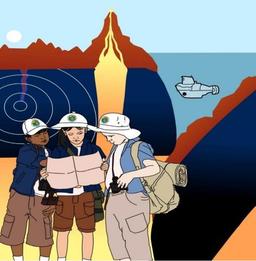
1ST QUARTER LONG TEST
Quiz by ARRIANE JOY ISORENA
Feel free to use or edit a copy
includes Teacher and Student dashboards
Measure skillsfrom any curriculum
Tag the questions with any skills you have. Your dashboard will track each student's mastery of each skill.
- edit the questions
- save a copy for later
- start a class game
- automatically assign follow-up activities based on students’ scores
- assign as homework
- share a link with colleagues
- print as a bubble sheet
- Q1
What makes up the Earth's lithosphere?
crust and core
crust and lower mantle
crust and upper mantle
oceanic and continental crust
30s - Q2
How will you differentiate continental crust from oceanic crust based on their thickness and density?
Continental crust is much thicker and denser than the oceanic crust.
Continental crust is thicker and less dense compared to oceanic crust.
Oceanic crust is thinner and less dense than the continental crust.
Both continental crust and oceanic crust have the same thickness and density.
30s - Q3
What do you call the rigid sections of the lithosphere that move as a unit?
Crust
Fault
Plates
Rocks
30s - Q4
One of the consequences of moving crustal plates is the occurrence of earthquakes. Which of the following is a must to perform during an earthquake?
Run as fast as you can.
Duck, cover and hold.
Stay inside the cabinet.
Move closer from steep elevations.
30s - Q5
What are the three types of waves released during the earthquake?
Love, Rayleigh and Water wave
Primary, Secondary, and Tertiary wave
Primary, Secondary and Long Surface wave
Water, Long Surface and Primary wave
30s - Q6
What do you call the method of locating earthquake epicenter by using data from three seismological stations?
Triangle Method
Triangular Method
Venn Diagram
Triangulation Method
30s - Q7
From the seismogram, the distance to the epicenter can be determined by measuring:
the difference in the arrival times of the P and S waves.
the arrival time of the surface wave.
the speed of the surface wave.
the ratio of the amplitude of the largest P and S waves.
30s - Q8
You are asked to locate the epicenter of a recent earthquake. Which correct sequence of events should you follow?
i. Determine the difference in the arrival time of P and S waves.
ii. Use the triangulation method to locate the center.
iii. Obtain data from three different seismological stations.
iv. Determine the distance of the epicenter from the station.
i, iii, ii, iv
iii, i, iv, ii
iii, iv, i, ii
iv, ii, i, iii
30s - Q9
What do you call the point on the Earth's surface directly above a focus or hypocenter, the point where an earthquake originates?
Epicenter
Fault
Intensity
Magnitude
30s - Q10
How will you describe the distribution of earthquake epicenters around the world?
They are not found on the continents.
The world's earthquake is found everywhere.
The world's earthquake is randomly distributed over the Earth's surface.
The world's earthquake is not randomly distributed over the Earth's surface.
30s - Q11
Why is there a need to identify the locations that are prone to earthquakes and volcanic eruptions?
In order to prepare for the possibility that they may occur.
It is important to identify any areas which are prone to a specific disaster for awareness and to save lives.
Because earthquakes and volcanic eruptions are incredibly powerful natural phenomena that can cause a huge amount of damage to human structures and human life.
All the answers are correct.
30s - Q12
What do you call the major area in the basin of the Pacific Ocean where a large number of earthquakes and volcanic eruptions occur?
Atlantic Ring of Fire
Bermuda Triangle
Pacific Ocean
Pacific Ring of Fire
30s - Q13
How will you relate the distribution of earthquake epicenters with the distribution of active volcanoes around the world?
Earthquake epicenters and volcanoes are situated separately.
Earthquake epicenters and volcanoes are situated in between.
Earthquake epicenters and volcanoes are both situated at the same plates.
Earthquake epicenters and volcanoes are both situated at the same locations.
30s - Q14
You are getting ready for school and an earthquake strike, what precautionary measures should be done during the earthquake?
Get out of the house as fast as you can.
Get in a closet and cover yourself with safety blankets.
Get under a desk, cover your head and neck and hold on.
Get in a doorway and brace yourself by holding onto the door frame.
30s - Q15
A tsunami very destructive because the force of the whole ocean is behind it. What should be done when you are near the sea and you feel a strong earthquake?
Secure your house roofs.
Do the "duck, cover and hold".
Take shelter under the nearest tree.
Run to the highest place you can find.
30s